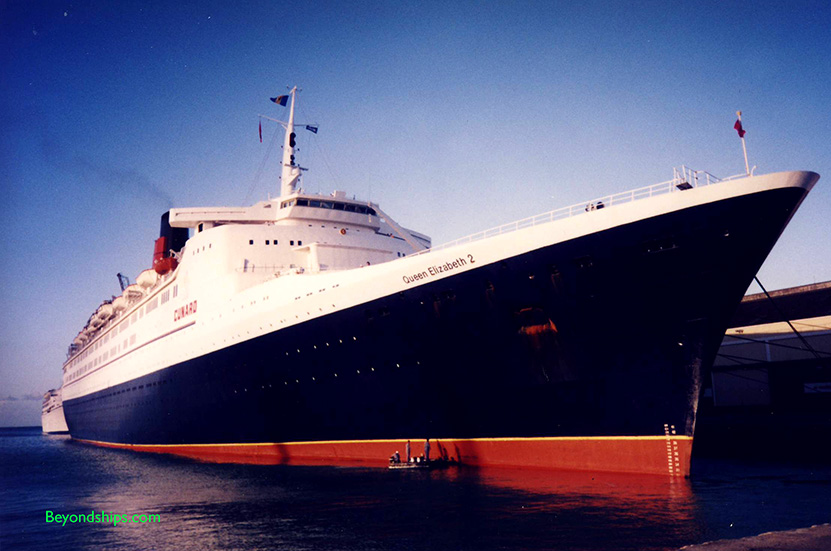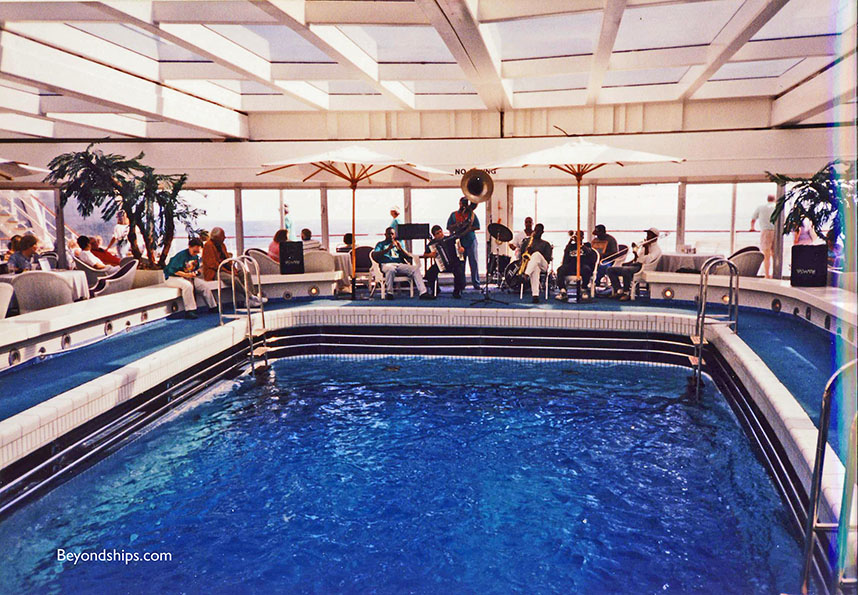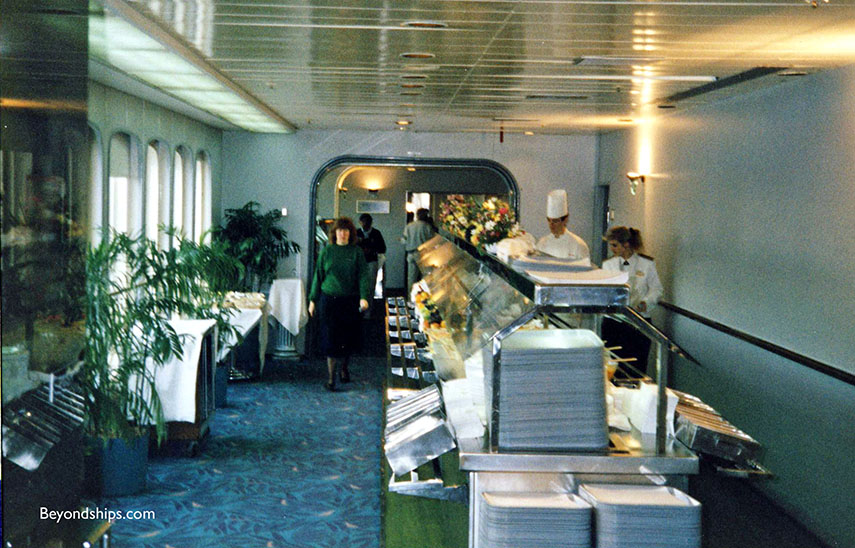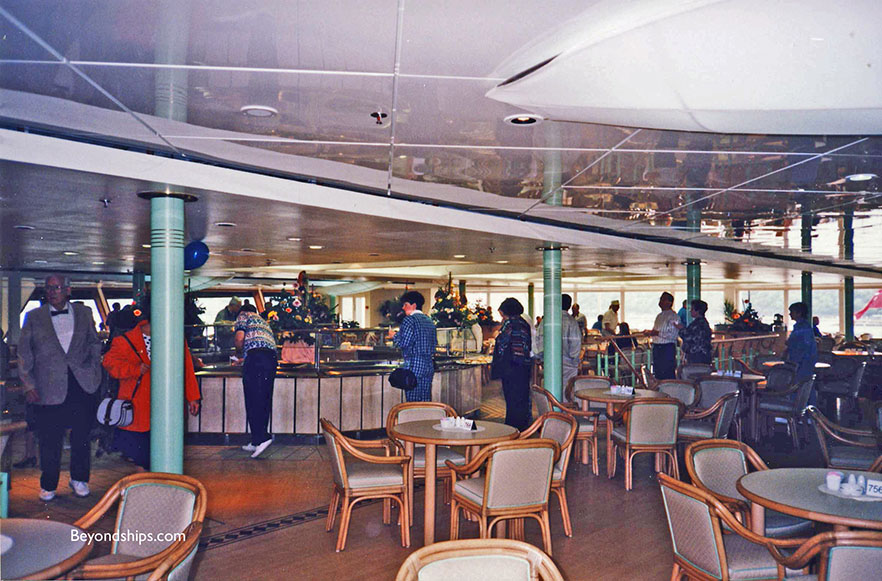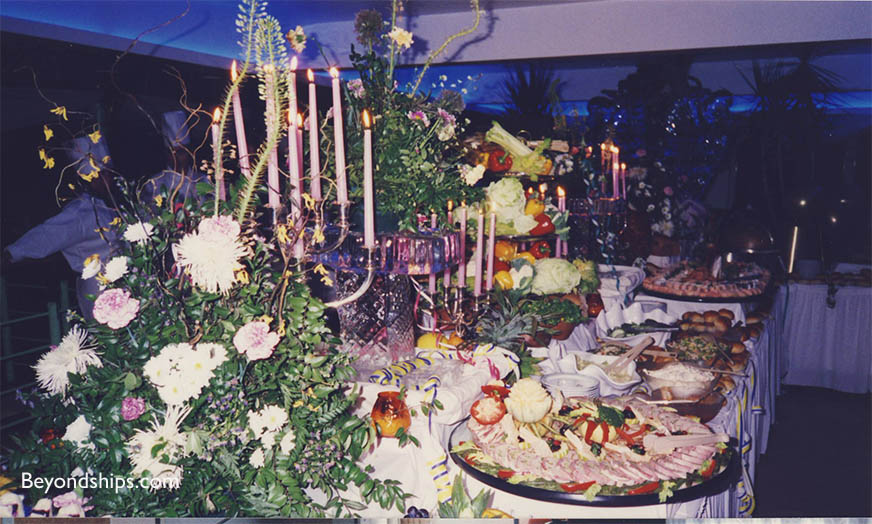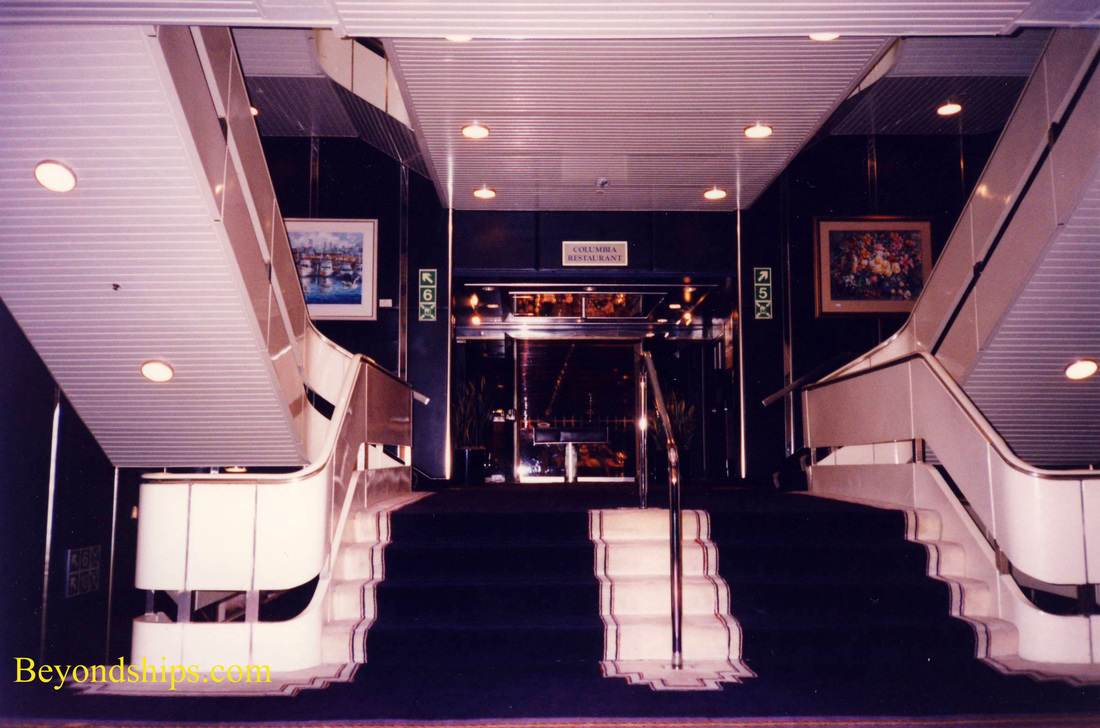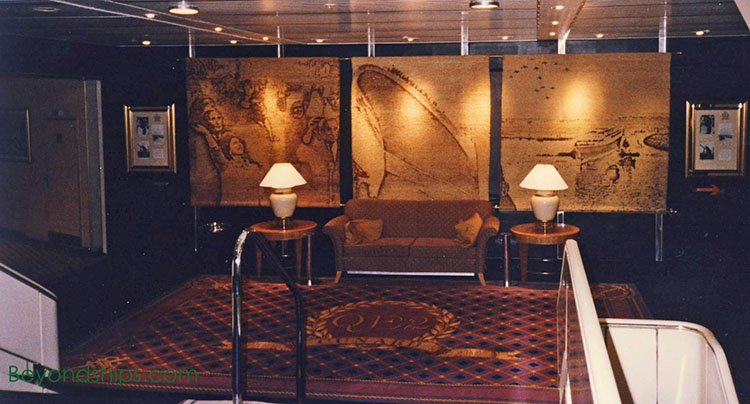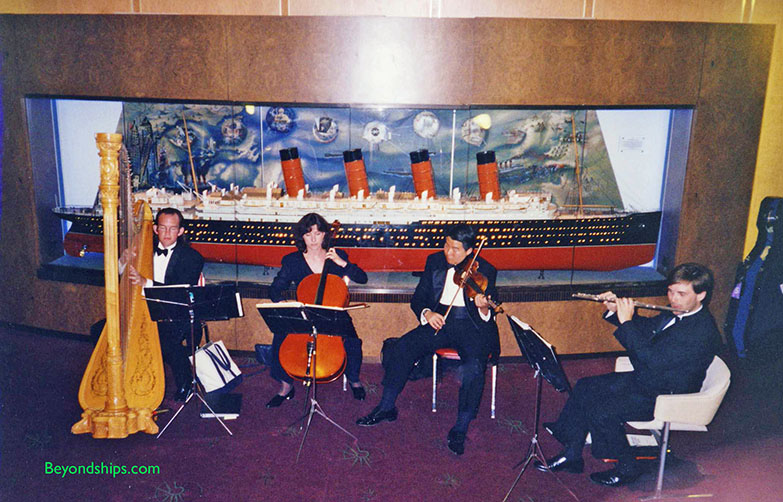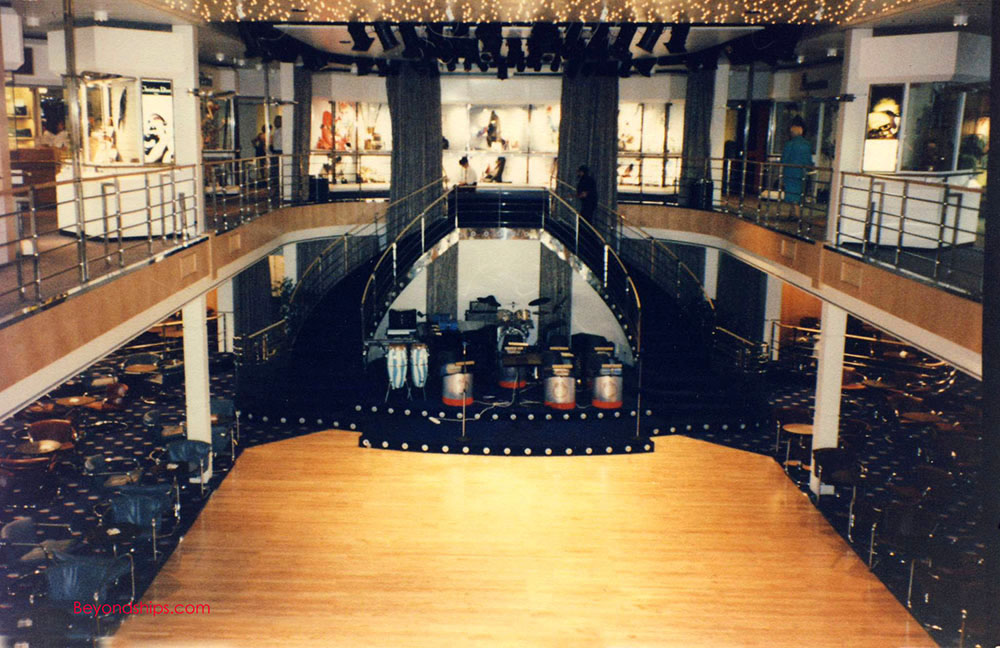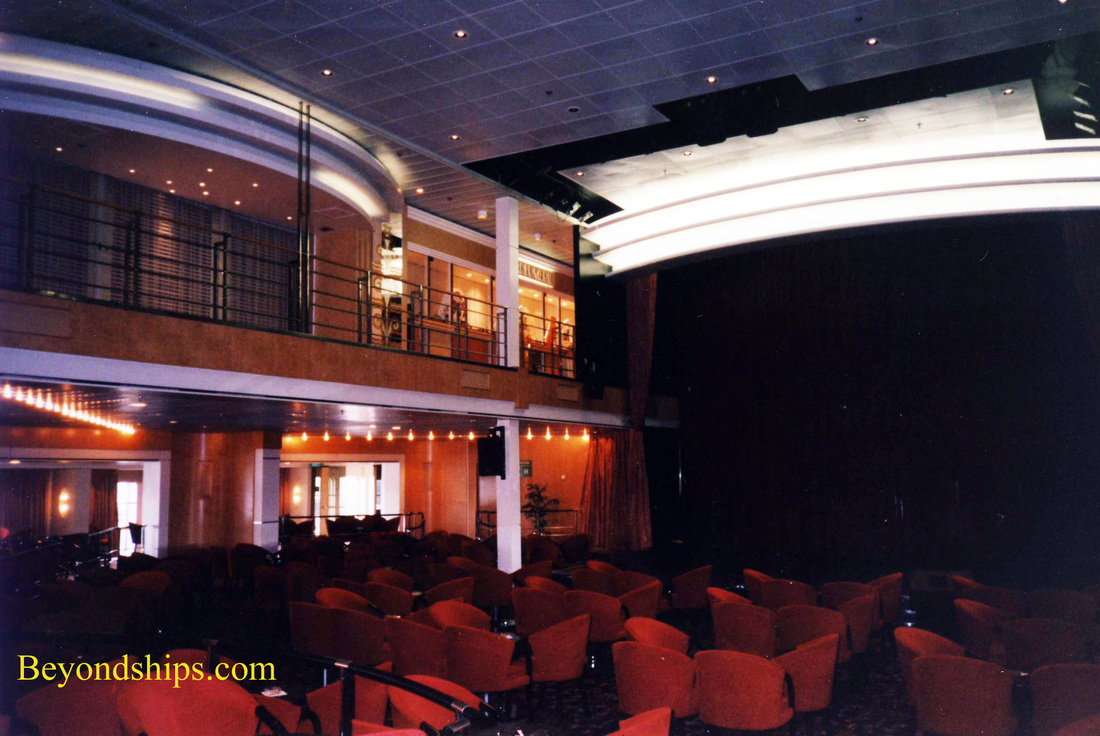|
CRUISE PICTORIAL
QUEEN ELIZABETH 2 1,000th voyage |
QE2 in 1995 with a new image. Her hull was painted dark blue and a "racing stripe" ran along either side of the superstructure.
|
|
E2's 1,000th voyage in the summer of 1995 was in many ways a turning point for the ship. In the preceding winter, the ship had undergone a massive refurbishment that had cost her owners some $45 million. However, because the work was not finished on time and because of an ill-judged decision to attempt to finish the work while the ship had passengers aboard, the ship received a massive amount of bad publicity. By June of 1995, the work had been completed and a new revitalized QE2 was ready to show what she could do. The 1,000th voyage presented an opportunity to do just that.
Some voices argued that it was not a good idea to talk to loudly about the fact that the ship had completed that many voyages. Wouldn't that just underscore that this was an old ship at a time when the public was enthralled with the new mega-cruise ships that the competition was starting to bring on the market? However, others, particularly those onboard QE2, wanted to celebrate. In the end, they won out even though the event was not marketed as strongly as other special sailings of QE2 have been over the years. It was a good thing that the celebration did take place. It was a flawless voyage both weather-wise and operationally. The new facilities and decor were as impressive as they were originally intended to be. The passengers and those in the media who covered the event saw that perhaps there still was something to the old ship. There would still be rough times ahead for QE2 and Cunard but at least this was the first step in a comeback. The 1994 Refit To put the 1000th voyage of QE2 in perspective, it is first necessary to look at the 1994 refit - - a disaster in the short term but also a step that enabled the ship to survive. In 1994, Cunard scheduled QE2 for a large-scale refit. Eight years before, there had been a massive technical renovation of the ship that changed her propulsion system from steam to diesel electric. Without that change, the ship could not have gone on sailing for very much longer. This new refit was aimed at revitalizing the the public rooms and passenger accommodations. It was every bit as ambitious as the 1986 re-engining. When the ship had gone into service in 1969, she had a unifying theme to her interior thanks largely to the head of the design team Dennis Lennon. It was a space-age design utilizing plastics, bright colors and pillars with swooping lines in an effort to make the new Cunarder reflect the Swinging Sixties rather than the boring, as Cunard's promotional literature put it, previous generation of ocean liners. Over the years, as her original style became passe, various rooms had been altered and redecorated at different times so that the ship had evolved into a polyglot of styles. One of the goals of this refit would be to unify the interior with a decor that was contemporary but which harkened back to the classic ocean liners. On the agenda were also a long list of changes that would involve altering the ship structurally. One of the larger projects was to convert the Quarter Deck pool area into a permanent buffet dining venue. Originally, the pool had been outdoors but it had been covered by a retractable glass roof in 1983. However, the roof almost always remained shut. It was too cold to open it on the North Atlantic run and when the ship was in tropical waters, opening the roof let out the air conditioning. In addition, the pool itself was rarely used. However, the area was not unoccupied. It was a pleasant place to sit with large picture windows offering scenic views. In addition, the practice of serving trays of food near the pool had evolved into a large-scale informal dining operation with large mobile carts that had to be wheeled in from the kitchens at the other end of the ship. Why not eliminate the useless roof and the seldom-used pool and turn the area into a permanent informal dining venue with the necessary support facilities, Cunard reasoned. It was to become the popular Lido buffet. Eliminating the Magrodome would also enable Upper Deck to be extended further astern. As it was, in order to get to the back of the ship along Upper Deck, one had to go out of the Yacht Club, past a paddle tennis court, then up a half-flight of stairs, walk between the Magrodome and two large tenders known as Alpha and Beta, and then back down a half flight of stairs. With the Magrodome gone, Upper Deck could be one level, the popular Yacht Club could be expanded and an area of open deck for sun worshipers could be created. In addition, a new sports area could be built on top of the expanded Yacht Club on Boat Deck. Alpha and Beta, which were impressive looking but never used, could be eliminated and replaced by catamaran-hulled tenders that would hang from davits along Boat Deck with the other lifeboats. Underneath the new Lido on One Deck, the designers conceived of a new room facing the outdoor pool. There had been an open hatch here where hamburgers and hot dogs were passed out to people sunning themselves by the pool. The new Pavilion would continue to serve such fare but it would have considerably more style than the old Hamburger Haven. Other major changes to the public rooms included the creation of the Crystal Bar, the transformation of the Midships Bar into the Chart Room, elimination of the Card Room and the creation of an expanded Library and Book Shop, changing the Theater Bar into the Golden Lion Pub and yet another redecoration of the Midships Lobby. The stairs in the Grand Lounge would be eliminated and the stage expanded. On the upper level, the shops would be redesigned. Another major change stemmed from a plan to upgrade some of the original transatlantic class cabins into higher (i.e., more expensive) cabin categories. If the cabins were upgraded, the passengers occupying them would not want to dine in the transatlantic class dining room. Therefore, the capacity of the dining room that served those cabin categories would have to be expanded. It would be impractical to do this to the existing dining room on Quarter Deck (then known as the Columbia Restaurant). So, the designers came up with a scheme to upgrade the original transatlantic class restaurant (then called the Mauretania restaurant) and make that into the restaurant that served the passengers in the higher cabin categories. The existing Mauretania Restaurant would then be renamed the Caronia Restaurant and the Columbia Restaurant would be called the Mauretania Restaurant. (For numerous reasons, this rather complicated scheme did not work and after a year, the restaurants were swapped back so that the Mauretania Restaurant is back in its original location. What had been the Columbia became the Caronia). In addition, the bathrooms in most of the passenger cabins were upgraded. Clearly, the planned refit was going to be a major undertaking. In November, QE2 completed its 1994 season with a cruise to the Caribbean that ended in New York. Indeed, workmen started coming onboard in Fort Lauderdale, the last port before New York. As a result, when the passengers were leaving, discarded furniture and furnishings followed them down the gangway. The ship then sailed without passengers to Hamburg, Germany where the bulk of the work was to be done. There was a look of doubt in some officers' eyes as to whether all this refurbishment could be done in time for QE2's upcoming world cruise in the beginning of January 1995. |
Above: The Quarter Deck Pool beneath the Magrodome added in 1983 was an attractive area. Indeed, many were sorry to see it go. In the photo above the Preservation Hall Jazz Band played an impromptu farewell at the end of the November 1993 Caribbean cruise just before the area was transformed in the 1994 refit.
Below: Unfortunately, the area was impractical as a dining venue operating with mobile serving carts stationed in the passageways connecting the pool area to the Queens Room. Above: The Lido informal dining area may not be as attractive as the Upper Deck pool area was but it is more practical.
Below: The Lido could, however, look spectacular during a gala midnight buffet. Above and below: D Stairway before the refit reflected the original 1960s contemporary decor of QE2. Cunard had adopted this decor becase the ocen liners of the past were "boring."
Above: During the refit, Cunard sought to evoke the aura of the ocean liners of the past. A giant model of the old Mauretania was added to the D Stairway landing where the tapestries had been.,
The Grand Lounge had had several names and several facelifts prior to the 1994 refit. Above: Before the refit. Below: After the refit.
|
Cruise photo feature - - Cunard Line - - Queen Elizabeth 2 1,000th voyage - - page 1
